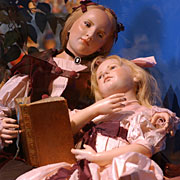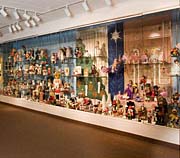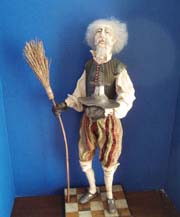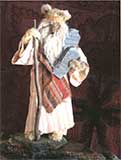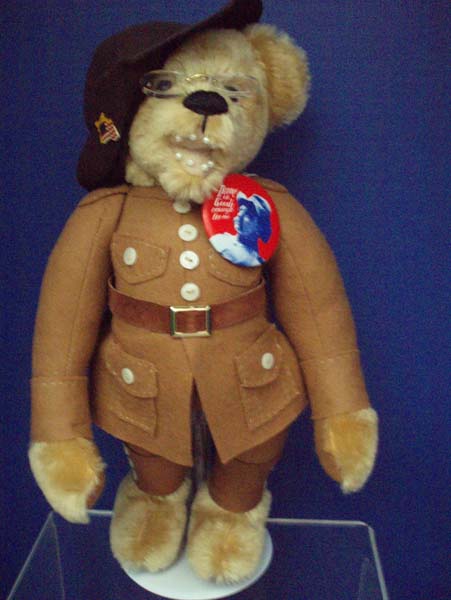![]()
GalleriesThe Museum display area begins just past the Gift Shop counter. You are first greeted by a beautiful work by Hildegard Gunzel called “The Reading Mother”. This work, which shows a mother reading to her daughter, was inspired by a poem of the same name by G. Strickland, and the inspirational verse is inscribed above the figures: You may have tangible wealth untold These near life-size dolls represent an overreaching theme of the entire Museum collection – the importance of books and reading, especially for children. The collections in the three galleries are displayed in state-of-the-art, custom-designed cases that comprise "walls of glass" – eighty (80) 4’x8’ sheets of one-half inch tempered glass stretching from wall-to-wall throughout the galleries. There also are sixty-five (65) 7’ tall stand alone display cases in the center of the three galleries. There are no partitions to impede your view of the contents. The suspended shelves are designed to sway if there is ever an earthquake to avoid damage to the collection. A popular comment by visitors is how the contents are “beautifully displayed”. Each of the three galleries has a different emphasis in its content. The Historical Gallery reflects the rich cultural heritage enjoyed by the residents of California as a result of the many ethnic groups that have made this State their home. Many of the current artists are finding new ways of using traditional artistic methods and symbols. The dolls and teddy bears are examples of folk, artist, and commercial dolls. The displays begin with the Native Americans, followed by dolls of the various groups that came to settle the State. The first were the Hispanics, who founded San Diego in 1769 and Santa Barbara in 1782. Santa Barbara was the site of one of only four Spanish Presidios in California (the others being San Diego, Monterey, and San Francisco). The Santa Barbara Mission was founded in 1786, and was the tenth mission to be build. The Spanish were followed by the Russians, Chinese, African-American, and Japanese. In 1945 the United Nations Charter was signed in San Francisco, a fitting location in a State that boasted the greatest diversity of ethnicities in its population. Interspersed with the dolls and teddy bears are models of the homes and architecture of various cultures, and even several different kinds of market places. California has been the home of a number of commercial doll and teddy bear companies. Some of those represented in the Museum include Nancy Ann Storybook Dolls, Paradise Galleries, Shindana, Dakin, Worlds of Wonder, Vogue, Terry Lee, and of course Disney and Mattel. On display are dolls designed by many of the talented California doll artists and even a number having Santa Barbara connections to the doll and teddy bear world. The Literary Gallery contains dolls and teddy bears that have been the subject of books or inspired by books. You will have fun revisiting old literary friends. While many of the books are children’s stories, adult books are represented as well. The Collector's Gallery has a variety of exhibits including a tribute to Teddy Roosevelt as the namesake of the American teddy bear. A display of teddy bears created by many renowned California artists is followed by a wide variety of bears in seasonal settings. A section on puppets focuses on some of the better-known characters such as Punch and Judy, Charlie McCarthy, Sheri Lewis’s Lambchop and Charlie Horse, and Howdy Doody and Buffalo Bob. Then a collection of fairy tale characters is displayed in an appropriate woodsy setting. Space toys have been popular for many years, and there is a comprehensive collection on display starting with a representation of the robot Maria from the 1924 movie Metropolis and including Mattel’s Matt Mason, Star Trek, Micronauts, Star Wars, Alien, Power Rangers, Mork, ET, and Independence Day. The next display contains dolls made from different media, such as cloth, wood, wax, metal, and bisque. There is also a display of children’s sewing machines showing the changes in their design over the years. The gallery concludes with a large Fairy Forest filled with mostly one-of-a-kind dolls and teddy bears.
|
|

Copyright 2023. All rights reserved. Material and photographs, in whole or part, contained on this web site
may not be reproduced, distributed, or used for any purposes without permission of Susan Quinlan.
